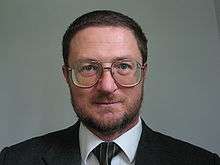Andrei Knyazev (mathematician)
Andrei (Andrew) Knyazev (Russian: Андрей Владимирович Князев) is a Russian-American mathematician. He graduated from the Faculty of Computational Mathematics and Cybernetics of Moscow State University under the supervision of Evgenii Georgievich D'yakonov (Russian: Евгений Георгиевич Дьяконов) in 1981 and obtained his PhD in Numerical Mathematics at the Russian Academy of Sciences under the supervision of Vyacheslav Ivanovich Lebedev (Russian: Вячеслав Иванович Лебедев) in 1985. He worked at the Kurchatov Institute in 1981–1983, and then to 1992 at the Marchuk Institute of Numerical Mathematics (Russian: ru:Институт вычислительной математики имени Г. И. Марчука РАН) of the Russian Academy of Sciences, headed by Gury Marchuk (Russian: Гурий Иванович Марчук).
Andrei (Andrew) Knyazev | |
|---|---|
 Andrew Knyazev | |
| Born | June 9, 1959 |
| Alma mater | Moscow State University |
| Known for | eigenvalue solvers |
| Awards | IEEE Senior Member (2013) Professor Emeritus University of Colorado Denver (2016) SIAM Fellow (2016) AMS Fellow (2019) |
| Scientific career | |
| Fields | Numerical analysis, Applied Mathematics, Computer Science |
| Institutions | Kurchatov Institute Institute of Numerical Mathematics Russian Academy of Sciences Courant Institute of Mathematical Sciences New York University University of Colorado Denver Mitsubishi Electric Research Laboratories |
| Doctoral advisor | Vyacheslav Ivanovich Lebedev |
| Website | https://www.linkedin.com/in/andrew-knyazev/ |
In 1993–1994, Knyazev held a visiting position at the Courant Institute of Mathematical Sciences of New York University, collaborating with Olof B. Widlund.[1] From 1994 until retirement in 2014, he was a Professor of Mathematics at the University of Colorado Denver, supported by the National Science Foundation[2] and United States Department of Energy grants. He was a recipient of the 2008 Excellence in Research Award,[3] the 2000 college Teaching Excellence Award, and a finalist of the CU President's Faculty Excellence Award for Advancing Teaching and Learning through Technology in 1999.[4] He was awarded the title of Professor Emeritus at the University of Colorado Denver[5] and named the SIAM Fellow Class of 2016[6] and AMS Fellow Class of 2019.[7]
In 2012–2018, Knyazev held a Distinguished Research Scientist position at the Mitsubishi Electric Research Laboratories (MERL).[8] His research at MERL was on algorithms for image and video processing, data sciences, optimal control, material sciences, and numerical simulation of complex phenomena, resulting in publications and 13 patent applications.[9]
Knyazev was mostly known for his work in numerical solution of large sparse eigenvalue problems, particularly preconditioning[10] and the iterative method LOBPCG.[11] Knyazev's reference implementation of LOBPCG was available in the public software package BLOPEX and, e.g., the electronic structure calculations library ABINIT for wavefunction parallel optimization.[12]
Knyazev collaborated with John Osborn [13] on the theory of the Ritz method in the finite element method context and with Nikolai Sergeevich Bakhvalov (Russian: Николай Серге́евич Бахвалов) (Erdős number 3 via Leonid Kantorovich) on numerical solution of elliptic partial differential equations with large jumps in the main coefficients.[14] Jointly with his Ph.D. students, Knyazev pioneered using majorization for bounds in the Rayleigh–Ritz method (see[15] and references there) and contributed to the theory of angles between flats.[16] [17]
References
- Knyazev, Andrew; Widlund, Olof (2003), "Lavrentiev Regularization + Ritz Approximation = Uniform Finite Element Error Estimates for Differential Equations with Rough Coefficients", Mathematics of Computation, 72: 17–40, doi:10.1090/S0025-5718-01-01378-3
- Knyazev's NSF awards
- Andrew Knyazev. 2008 Excellence in Research and Creative Activities Award Winner, 1 May 2008
- Goodland, Marianne (6 May 1999), "President's Faculty Excellence Award for Advancing Teaching and Learning through Technology", Silver & Gold Record, XXIX (34)
- Professor Emeritus University of Colorado Denver, 6 January 2016
- Society for Industrial and Applied Mathematics (SIAM) Fellows Class of 2016, 31 March 2016
- American Mathematical Society (AMS) Fellows Class of 2019, 31 October 2018
- Andrew Knyazev moved to MERL, 2012
- Knyazev's Website at Mitsubishi Electric Research Laboratories Archived January 20, 2018, at the Wayback Machine
- Knyazev, A.V. (1998), "Preconditioned eigensolvers - an oxymoron?" (PDF), Electron. Trans. Numer. Anal. (ETNA), 7: 104–123
- Knyazev, A.V. (2001), "Toward the Optimal Preconditioned Eigensolver: Locally Optimal Block Preconditioned Conjugate Gradient Method", SIAM Journal on Scientific Computing, 23 (2): 517–541, doi:10.1137/S1064827500366124
- Bottin, F.; Leroux, S.; Knyazev, A.; Zerah, G. (2008), "Large scale ab initio calculations based on three levels of parallelization", Computational Materials Science, 42 (2): 329–336, arXiv:0707.3405, doi:10.1016/j.commatsci.2007.07.019
- Knyazev, A.V.; Osborn, J. (2006), "New A Priori FEM Error Estimates for Eigenvalues", SIAM J. Numer. Anal., 43 (6): 2647–2667, doi:10.1137/040613044
- Bakhvalov, N.S.; Knyazev, A.V.; Parashkevov, R.R. (2002), "Extension Theorems for Stokes and Lamé equations for nearly incompressible media and their applications to numerical solution of problems with highly discontinuous coefficients", Numerical Linear Algebra with Applications, 2 (2): 115–139, doi:10.1002/nla.259
- Knyazev, A.V.; Argentati, M.E. (2010), "Rayleigh–Ritz majorization error bounds with applications to FEM", SIAM J. Matrix Anal. Appl., 31 (3): 1521–1537, arXiv:math/0701784, doi:10.1137/08072574X
- Knyazev, A.V.; Argentati, M.E. (2006), "Majorization for Changes in Angles Between Subspaces, Ritz Values, and Graph Laplacian Spectra", SIAM J. Matrix Anal. Appl., 29 (1): 15–32, arXiv:math/0508591, doi:10.1137/060649070
- Knyazev, A.V.; Jujunashvili, A.; Argentati, M.E. (2010), "Angles between infinite dimensional subspaces with applications to the Rayleigh–Ritz and alternating projectors methods", Journal of Functional Analysis, 259 (6): 1323–1345, arXiv:0705.1023, doi:10.1016/j.jfa.2010.05.018
External links
- Andrei Knyazev publications indexed by Google Scholar
- Andrei Knyazev's publications indexed by the Scopus bibliographic database. (subscription required)
- Andrei Knyazev at the Mathematics Genealogy Project
- Patents granted to Andrei Kniazev and patent applications filed by Andrei Kniazev at USPTO and world-wide
- MathSciNet (subscription required) reviews for Andrew Knyazev
- Zentralblatt MATH (subscription required) reviews
- arXiv Reports
- SIGPORT Contributions
- Block Locally Optimal Preconditioned Eigenvalue Xolvers (BLOPEX)
- Knyazev's software in MATLAB
- Website at the University of Colorado Denver
- Andrei Knyazev on LinkedIn